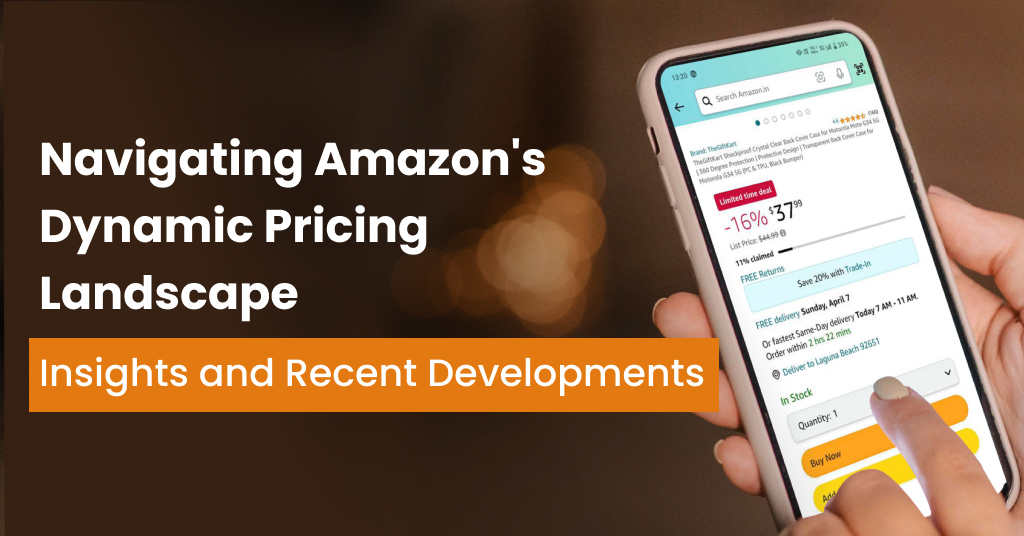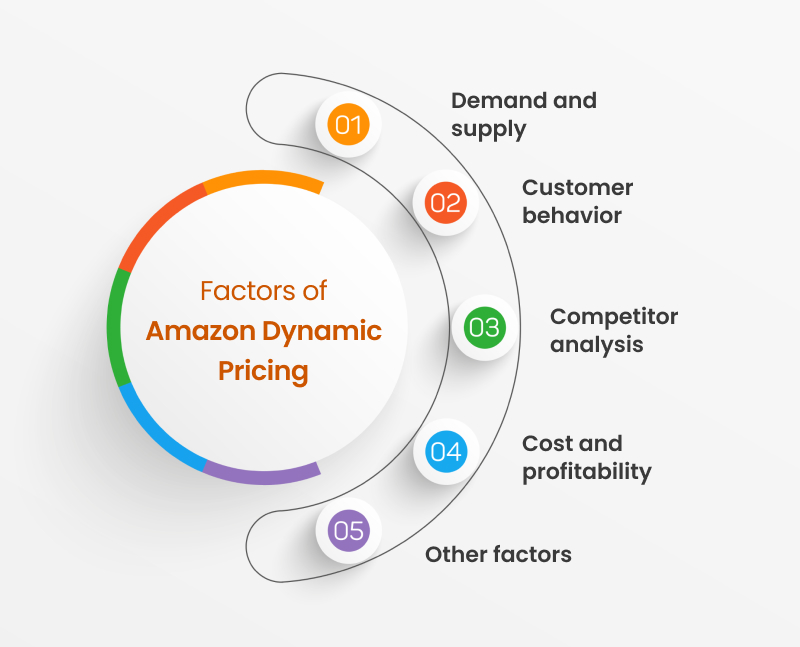
In the words of Warren Buffet, “The single most important decision in evaluating a business is pricing power. If you’ve got the power to raise prices without losing business to a competitor, you’ve got a very good business.” Amazon implemented the idea behind this statement in 2012 – when it implemented dynamic pricing or repricing.
Amazon has a sophisticated algorithm in place to update the prices of millions of products multiple times a day based on factors such as
- Demand
- Time of the day
- Customer’s browsing history
- Competitor prices,
- Market trends.
But, why does Amazon employ dynamic pricing, and how does it impact sellers? What strategies can sellers implement to maximize profits while adhering to Amazon’s pricing guidelines? Join us as we uncover the answers to these questions and share the latest updates on Amazon’s dynamic pricing. Learn how businesses like yours can optimize pricing strategies to remain competitive in the ever-evolving marketplace.
Table of Content
Understanding the concept of Amazon’s dynamic pricing
As the term implies, “dynamic” denotes constant change, and that’s what Amazon’s dynamic pricing strategy, also known as repricing, is all about. As the leading global eCommerce marketplace, Amazon employs a strategic approach wherein product prices are adjusted in real time based on multiple factors.
To illustrate, consider airlines, which frequently modify ticket prices depending on seat availability, booking time, and demand. Airlines may raise prices during peak travel periods or when seats are limited to capitalize on growing demand. Conversely, in off-peak periods or when flights are undersold, prices may be reduced to attract more customers and fill empty seats. This dynamic pricing method empowers airlines to optimize revenue while still offering competitive prices to customers.
Similarly, Amazon dynamically adapts to shifts in demand, competitor pricing, seasonality, and other market variables. Harnessing the capabilities of Artificial Intelligence and Machine Learning, Amazon’s pricing strategy is ever-evolving and responsive. This approach strikes a balance between profitability and competitiveness, with a commitment to prioritizing customer satisfaction.
How does Amazon dynamic pricing work?
Amazon’s dynamic pricing algorithms are complex and constantly evolving, but several key factors influence their decisions.

1) Demand and supply
- Product demand: High demand leads to potential price increases, while low demand may trigger discounts. Seasonality, trends, and competitor activity all play a role in demand estimations.
- Inventory levels: Limited inventory for popular products might justify price hikes, while overstocked items could see reductions.
2) Customer behavior
- Purchase history: Amazon analyzes individual buying patterns and preferences to personalize prices. Frequent buyers or those with higher purchase values might see better deals.
- Browsing behavior: Time spent on product pages, cart abandonment rates, and click-through rates can all influence dynamic pricing decisions.
3) Competitor analysis
- Competitor pricing: Amazon constantly monitors pricing across various marketplaces and adjusts its prices accordingly to remain competitive.
- Product comparisons: Customers often compare prices before buying, so Amazon considers similar offerings and may undercut or match pricing strategically.
4) Cost and profitability
- Cost of goods sold: The minimum price for any product is usually dictated by production and selling costs.
- Target profit margin: Sellers define their desired profit margins, and algorithms adjust prices to optimize profitability within market constraints.
5) Other factors
- Time of day and day of the week: Prices can fluctuate based on peak buying times and purchasing patterns throughout the week.
- Special events and promotions: Holiday seasons, flash sales, and other promotional periods influence Amazon pricing strategies.
- Location and geography: Different regions may see varied pricing due to shipping costs, currency fluctuations, and local demand variations.
It’s important to remember that these factors interact and influence each other in complex ways. Amazon’s algorithms analyze massive amounts of data in real-time, making hundreds of micro-adjustments to prices throughout the day. While the exact inner processes remain somewhat opaque, understanding these key factors can help sellers anticipate price changes and develop effective dynamic pricing strategies.
What’s new in Amazon’s dynamic pricing model – The latest updates
Remaining competitive and achieving success in the Amazon marketplace requires sellers to stay abreast of the latest updates in the dynamic pricing landscape. Adapting strategies accordingly is crucial in light of these recent developments.
Algorithm tweaks
1. Improved demand forecasting: Amazon’s algorithms are becoming better at predicting future demand fluctuations based on seasonality, competitor activity, and global events. This allows for more precise dynamic pricing adjustments.
2. Enhanced competitor monitoring: The algorithms are proactively tracking competitor pricing across various marketplaces and adjusting prices accordingly. This fosters greater competitiveness for sellers.
3. Personalized pricing: AI is playing a major role in tailoring prices according to individual customers based on their past purchase behavior, demographics, and browsing history. This allows for more targeted promotions and value creation.
New tools and features
1. Automated repricing rules: Sellers can set up custom pricing rules based on inventory levels, competitor prices, or profit margins. This automates price adjustments and saves time.
2. Advanced analytics dashboard: Amazon provides comprehensive data and insights on pricing performance, demand trends, and competitor activity. This empowers sellers to make informed pricing decisions.
Overall trends
1. Increased transparency: There’s a growing push towards transparency in dynamic pricing practices. Amazon is making efforts to inform sellers about how their pricing algorithms work and the factors influencing price adjustments.
2. Focus on fairness and value: While maximizing profits is important, Amazon emphasizes the need for fair and competitive pricing to maintain customer trust and satisfaction. The pricing strategies should be driven by offering value to different customer segments.
3. Integration with other services: Integration with Amazon services like advertising, inventory management, or fulfillment is on the go. This will create a more holistic and optimized selling experience.
Position your store as a leader in price intelligence, ensuring alignment with Amazon’s standards.
Explore Amazon-aligned strategies created by subject matter experts
Where to go from here: Tactics for sellers
To stay relevant and competitive, sellers must move along the dynamic pricing structure by implementing ways and means. Here are some of the proven techniques, as suggested by Amazon price optimization experts:
1. Strategic pricing intelligence
- Competitor analysis: Regularly monitor competitor pricing to stay informed about market trends. Identify opportunities to strategically adjust your prices based on the competitive landscape.
- Data analytics: Leverage advanced analytics tools to gain insights into customer behavior, demand patterns, and competitor strategies. Analyze this data to refine your pricing approach and identify areas for improvement.
2. Optimizing product listings
- Keyword optimization: Invest in thorough keyword research and optimize your product listings. Well-optimized listings can positively influence your product’s visibility and increase the likelihood of inclusion in dynamic pricing adjustments.
- Accurate information: Ensure that your product information is accurate, comprehensive, and up-to-date. Clear and detailed listings contribute to a positive customer experience and can impact dynamic pricing outcomes.
3. Utilizing Amazon tools
- Seller Central insights: Regularly check Amazon Marketplace Seller Central for valuable insights into inventory levels, sales trends, and customer reviews. You can use this information to make informed decisions about your pricing strategy.
- Brand Analytics: Leverage Amazon’s Brand Analytics to gain a deeper understanding of customer demographics and preferences. This information can be instrumental in tailoring your pricing to specific customer segments.
4. Effective pricing strategies
- Competitive base prices: Start with competitive base prices to ensure your products are considered in the dynamic pricing algorithm. Find a balance between competitiveness and profitability.
- Price limits: Set minimum and maximum price limits in line with your profit margins. This ensures dynamic pricing adjustments remain within acceptable boundaries, preventing potential loss.
- Automated repricing tools: Experiment with third-party repricing tools that automatically adjust prices based on real-time market data. Monitor their impact closely and fine-tune settings to align with your business goals.
5. Flexibility and customer-centric approach
- Adaptability: Adjust to frequent price fluctuations and be prepared to adapt swiftly. Stay agile in modifying your pricing strategy and inventory levels based on market dynamics.
- Product differentiation: Differentiate your products by offering unique features, bundles, or variations. This reduces the reliance on price alone and helps build customer loyalty through perceived value.
- Customer feedback: Monitor customer reviews and feedback related to pricing changes. Use this feedback to make informed adjustments to your strategies, ensuring a positive brand image and customer satisfaction.
Discover the potential of your Amazon store with a complimentary store audit
How to go about it: Seeking support to navigate Amazon’s dynamic pricing
In the dynamic world of Amazon pricing, sellers can benefit from the expertise of:
1. Amazon consultants and agencies
- Expert guidance: Engage consultants for insights into Amazon’s algorithms and personalized strategies.
- Strategic planning: Agencies can assist in comprehensive planning and adherence to Amazon guidelines.
2. Data analytics professionals
- In-depth analysis: Collaborate with data experts to analyze sales data, customer behavior, and market trends.
- Predictive modeling: They can help you Forecast demand and identify optimal pricing points with predictive modeling.
3. Legal and compliance experts
- Adherence to policies: These experts can ensure compliance with Amazon policies to avoid penalties.
- Policy updates: Stay informed about policy changes and navigate updates with legal professionals.
4. Industry forums and communities
- Shared experiences: Learn from fellow sellers in online communities to navigate dynamic pricing challenges.
- Best practices: Stay updated on eCommerce best practices through industry forums.
5. Educational platforms and courses
- Continuous learning: Explore eCommerce courses to stay informed on dynamic pricing strategies and tools.
- Skill enhancement: Invest in skill development to gain a deeper understanding of dynamic pricing dynamics.
Don’t know where to start?
Schedule a free call with Amazon experts today. Engage in a conversation with professionals who can guide you through the intricacies of dynamic pricing models, offering tailored advice for your store. Take advantage of this opportunity to ensure long-lasting success by making informed decisions.

